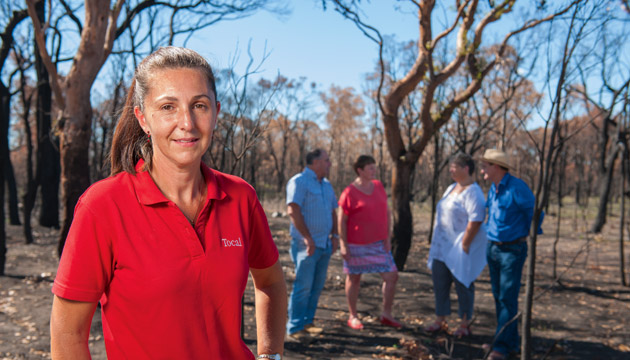Through floods, fires, droughts and challenging changes, a swag of rural characters and communities have become renowned for their resilience.
Story Amanda Burdon Photo Allen Davis
Few things will test a family’s resilience quite like fire. Except perhaps a health crisis. South Australian sheep breeders Nette and Troy Fischer faced both during a tumultuous period in 2015–16.
“I had spent several months in hospital in Townsville with our youngest child, after she arrived 16 weeks early,” Nette says. “I had just returned home to Wasleys [north-west of Gawler, SA], and I was thrilled to be reunited with Troy and the older girls.” But the excitement was short-lived when a large blaze engulfed their Ashmore White Suffolk stud.
“Extreme wind from the north-west swung to the west and very quickly a small fire turned into a 40-kilometre front,” Troy says. “After seeing the first plumes of smoke I left with one of our daughters, the computer, a few precious items and the dog. Twenty minutes later the farm was ablaze. Fortunately, Nette and the other two girls were not home.”
In the end, dedicated fire crews and water bombing saved the two houses on the Fischers’ property, but the rest was razed, “right up to the verandah posts”, and they lost their entire breeding flock – either in the fire or later, due to horrific burns. Some 1000 bales of hay secured in four locations to minimise fire risk were also destroyed, along with sheds, machinery and 35km of fencing.
“It was like Armageddon; like an atomic bomb had gone off,” says Troy of the fire that swept across some 80,000 hectares of farmland. But the very night of the blaze, surrounded by blackened earth and sheep carcasses, the couple began making plans. “We agreed that if anyone offered help, we would accept it,” Nette says. “That decision dramatically changed the outcome for us. It was such a big job cleaning up, destroying sheep and getting the surviving sheep to food and water and into fenced paddocks to be vet checked.”
The Fischers also broke into two teams – Troy to look after the agistment of the surviving 550 sheep and to consider how to replace the breeding flock, and his father Brian to rebuild fences. BlazeAid volunteers provided critical physical support, and the generosity of neighbours and colleagues in the months that followed was heartwarming.
“We had people dropping off food and total strangers dropping off hay,” Troy says. “People came with trailers, guns and generators. Friends in the middle of harvest dropped everything to load their trucks with dead sheep and cart them away. The kindness was unbelievable; that’s what buoyed us, especially in the early days.”
But Nette and Troy’s own attitude and prompt action was just as important. “I am the fourth-generation on this property; we have been here for over 100 years and we plan to be here for another 100,” Troy says. “We decided to dig in and get on with it. It never occurred to us to move away.”
Instead, the Fischers saw a property bereft of fences and most infrastructure as a once-in-a-lifetime opportunity. “This farm was designed for the horse and cart, not B-double trucks,” Troy says. “While the fire was challenging, it also gave us the chance to improve things and to plan for the future, to decide whether the gates and sheds were actually in the right spots and redesign the fencing.”
A month after the fire, the Fischers asked six of the country’s best stud breeders if they would contribute some of their ewes to an embryo transfer program. All agreed and gifted 20 top ewes, which went on to produce 300 elite embryos. Another sheep stud even lent the Fischers 75 of their keeper stud ewes for a year to get a drop of lambs. “They all gave us something that money couldn’t buy,” Troy says. “It was a huge boost to know that we would have top animals on the ground within six months of the fire.
“With finite resources, there was a lot we had to act on quickly and we sought all kinds of professional advice. If I thought too much about what we had been through, I would fall to pieces. I was constantly looking forward, not in the rear-view mirror.
This story excerpt is from Issue #112
Outback Magazine: Apr/May 2017









